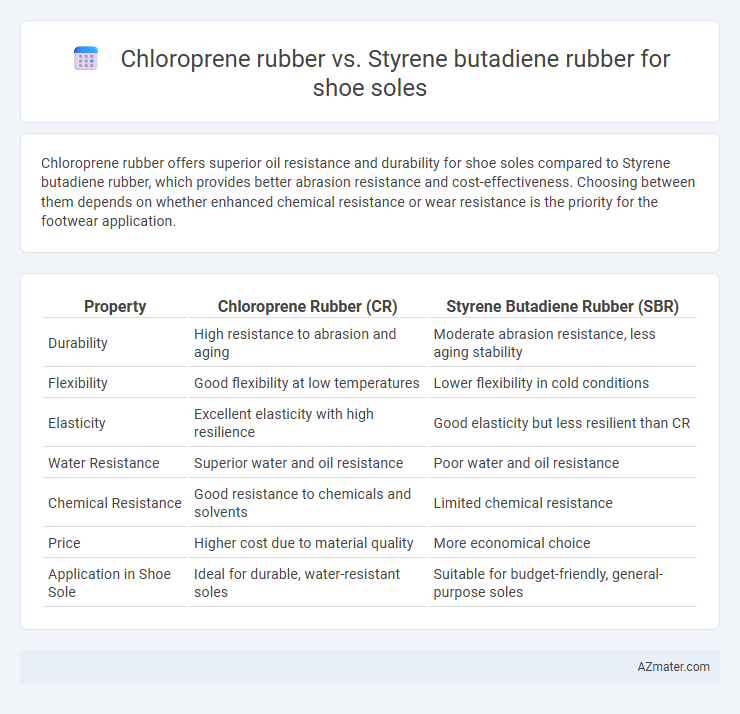Chloroprene rubber offers superior oil resistance and durability for shoe soles compared to Styrene butadiene rubber, which provides better abrasion resistance and cost-effectiveness. Choosing between them depends on whether enhanced chemical resistance or wear resistance is the priority for the footwear application.
Table of Comparison
| Property | Chloroprene Rubber (CR) | Styrene Butadiene Rubber (SBR) |
|---|---|---|
| Durability | High resistance to abrasion and aging | Moderate abrasion resistance, less aging stability |
| Flexibility | Good flexibility at low temperatures | Lower flexibility in cold conditions |
| Elasticity | Excellent elasticity with high resilience | Good elasticity but less resilient than CR |
| Water Resistance | Superior water and oil resistance | Poor water and oil resistance |
| Chemical Resistance | Good resistance to chemicals and solvents | Limited chemical resistance |
| Price | Higher cost due to material quality | More economical choice |
| Application in Shoe Sole | Ideal for durable, water-resistant soles | Suitable for budget-friendly, general-purpose soles |
Overview of Chloroprene Rubber and Styrene Butadiene Rubber
Chloroprene rubber (CR) offers superior resistance to weathering, ozone, and oils, making it ideal for durable shoe soles exposed to harsh conditions. Styrene butadiene rubber (SBR) is valued for its excellent abrasion resistance and affordability, often used in shoe soles requiring good wear performance at a lower cost. Both CR and SBR provide flexibility and resilience, but CR's enhanced chemical stability distinguishes it in premium footwear applications.
Chemical Composition and Structure
Chloroprene rubber (CR) consists primarily of polychloroprene, featuring chlorine atoms that enhance its chemical stability and resistance to oils, heat, and weathering, making it highly durable for shoe soles. Styrene butadiene rubber (SBR) is a copolymer of styrene and butadiene, characterized by a more flexible polymer chain that provides excellent abrasion resistance and cost-effective elasticity in footwear applications. The chlorine in CR creates stronger intermolecular bonding compared to the hydrocarbon backbone of SBR, resulting in superior chemical resistance but slightly reduced flexibility.
Mechanical Strength and Durability
Chloroprene rubber (CR) offers superior mechanical strength and excellent abrasion resistance, making it highly durable for shoe sole applications exposed to harsh conditions. Styrene butadiene rubber (SBR) provides good wear resistance and flexibility but generally shows lower tensile strength and aging resistance compared to CR. CR's enhanced chemical stability and resistance to oils and weathering contribute to longer-lasting shoe soles under demanding use.
Flexibility and Comfort in Footwear Applications
Chloroprene rubber offers superior flexibility and excellent abrasion resistance, making it ideal for shoe soles requiring durable yet pliable materials. Styrene butadiene rubber provides good comfort through its shock absorption properties but is less flexible compared to chloroprene, which can affect long-term wearability. Footwear applications prioritizing flexibility and comfort often favor chloroprene rubber for enhanced performance under dynamic movements.
Slip Resistance and Traction Performance
Chloroprene rubber offers superior slip resistance and traction performance compared to Styrene Butadiene Rubber (SBR) in shoe soles due to its excellent elasticity and strong grip on various surfaces, including wet and oily conditions. Its enhanced abrasion resistance and flexibility maintain consistent outsole contact, reducing the risk of slips and providing stable footing. In contrast, SBR tends to have lower slip resistance and traction under challenging conditions, making Chloroprene a preferred choice for high-performance footwear requiring reliable safety features.
Weather and Temperature Resistance
Chloroprene rubber offers superior weather resistance and maintains flexibility in a wider temperature range, making it ideal for shoe soles exposed to harsh climates. Styrene butadiene rubber, while cost-effective and abrasion-resistant, tends to harden and crack under prolonged cold or UV exposure. Chloroprene's enhanced ozone and chemical resistance ensures longer durability and performance in varying weather conditions.
Cost Analysis and Market Availability
Chloroprene rubber (CR) offers superior durability and weather resistance compared to Styrene Butadiene Rubber (SBR), but its higher production costs lead to a more expensive price point for shoe soles. SBR remains the most cost-effective option due to its widespread availability and lower raw material expenses, making it the preferred choice for mass-market footwear manufacturing. Market availability favors SBR with extensive global supply chains, whereas CR is less common and primarily used in premium or specialty shoe sole applications.
Environmental Impact and Sustainability
Chloroprene rubber (CR) exhibits moderate biodegradability but releases volatile organic compounds (VOCs) during production, contributing to environmental concerns, while Styrene butadiene rubber (SBR) relies heavily on petrochemical sources with limited recyclability, raising sustainability challenges. CR offers better resistance to ozone and weathering, potentially extending shoe sole lifespan and reducing waste compared to SBR, which degrades faster under environmental stress. Lifecycle assessments indicate CR's environmental impact is mitigated by durability, whereas SBR demands improvement in sourcing renewable feedstocks and enhancing end-of-life recyclability to achieve sustainability goals.
Common Shoe Brands Utilizing Each Material
Chloroprene rubber, known for its excellent resistance to oil, weather, and abrasion, is commonly used by brands like Nike and Adidas in high-performance athletic and outdoor shoe soles. Styrene butadiene rubber (SBR), valued for its cost-effectiveness and good abrasion resistance, is frequently utilized by more budget-friendly and casual footwear brands such as Skechers and Vans. The material choice directly impacts durability, flexibility, and grip, aligning with the specific performance needs of each brand's target market.
Final Comparison: Which Rubber is Best for Shoe Soles?
Chloroprene rubber offers superior abrasion resistance, weatherability, and flexibility, making it highly suitable for durable and high-performance shoe soles. Styrene butadiene rubber, while more cost-effective, provides moderate wear resistance and elasticity but falls short in long-term durability and resistance to oils and chemicals. For premium shoe soles requiring enhanced longevity and resilience, chloroprene rubber is the optimal choice, whereas styrene butadiene rubber suits budget-conscious applications with moderate performance needs.

Infographic: Chloroprene rubber vs Styrene butadiene rubber for Shoe sole
 azmater.com
azmater.com